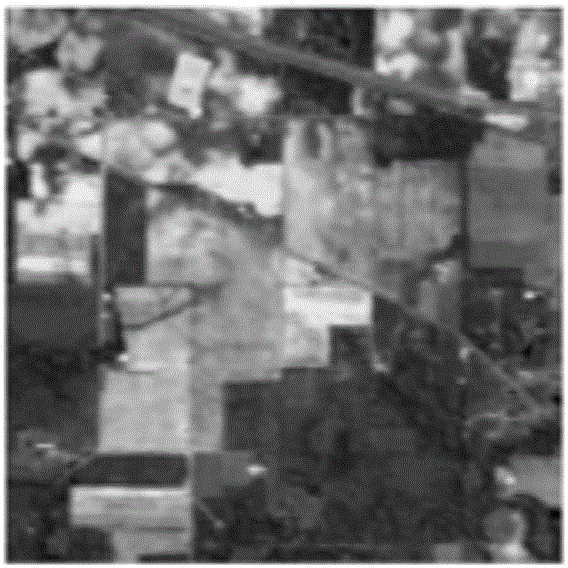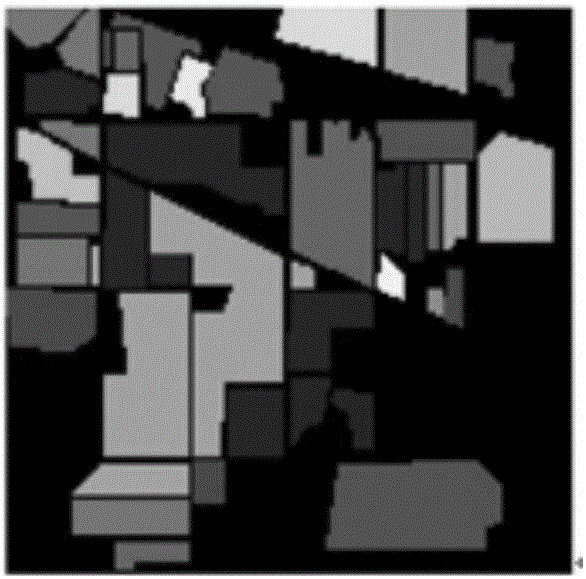Hyperspectral image segmentation method based on kernel method
A hyperspectral image and image segmentation technology, applied in image analysis, image enhancement, image data processing and other directions, can solve the problems of Haghes phenomenon and low image classification accuracy, achieve a wide range of use, realize hyperspectral image segmentation processing, large-scale The effect of applying value
- Summary
- Abstract
- Description
- Claims
- Application Information
AI Technical Summary
Problems solved by technology
Method used
Image
Examples
specific Embodiment approach 1
[0018] Specific implementation mode one: as figure 1 As shown, a hyperspectral image segmentation method based on the kernel method includes the following steps:
[0019] Step 1: Preprocessing the hyperspectral image data;
[0020] Step 2: clustering the preprocessed hyperspectral image data;
[0021] Step 3: Map the preprocessed hyperspectral image data and cluster centers to a high-dimensional space through a kernel function;
[0022] Step 4: Carry out image segmentation in the kernel function mapping space according to the image segmentation algorithm.
[0023] The hyperspectral image data is preprocessed, and the cluster center is found by clustering. Map the data and cluster centers to a high-dimensional space, and apply the kernel-mapped data to the graph cut function to obtain image segmentation results.
specific Embodiment approach 2
[0024] Embodiment 2: The difference between this embodiment and Embodiment 1 is that the preprocessing of the hyperspectral image data in the step 1 is as follows:
[0025] The KPCA method in the feature extraction method is used for dimension reduction processing, and the KPCA is a kernel-based principal component analysis.
[0026] In hyperspectral data analysis, measurement complexity is related to the number of bands and quantification accuracy. The more image bands and the higher the quantization accuracy, the greater the complexity of the data. There is an optimal data complexity that can optimize the classification accuracy. If the data dimension is high and the quantization accuracy is too high, the classification accuracy will decrease, which is the famous Haghes phenomenon. Dimensionality reduction is an important means to eliminate the Haghes phenomenon, so the preprocessing method adopted in the algorithm adopts the KPCA method in the feature extraction method fo...
specific Embodiment approach 3
[0028] Specific embodiment three: the difference between this embodiment and specific embodiment one or two is that: the specific process of clustering in the step two is:
[0029] Clustering is the process of dividing a collection of physical or abstract objects into classes, where each class is composed of similar objects. The collection of a group of data objects obtains a cluster generated by clustering. The objects in the same cluster are similar to each other, and the objects in different clusters are different from each other. In this algorithm, the K-means clustering method is used to cluster the data. .
[0030] Basic principle: The basic idea of the K-means clustering method is to select K points from the data sample as the initial value of the cluster center, and move each cluster center successively during the iteration process until the cluster centers of two adjacent iterations do not change. , the clustering criterion function reaches the optimum.
[0031] ...
PUM
 Login to View More
Login to View More Abstract
Description
Claims
Application Information
 Login to View More
Login to View More - R&D
- Intellectual Property
- Life Sciences
- Materials
- Tech Scout
- Unparalleled Data Quality
- Higher Quality Content
- 60% Fewer Hallucinations
Browse by: Latest US Patents, China's latest patents, Technical Efficacy Thesaurus, Application Domain, Technology Topic, Popular Technical Reports.
© 2025 PatSnap. All rights reserved.Legal|Privacy policy|Modern Slavery Act Transparency Statement|Sitemap|About US| Contact US: help@patsnap.com



